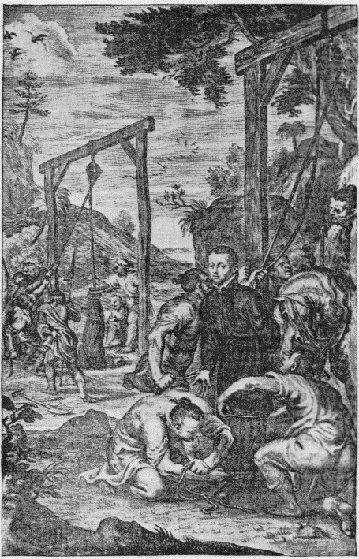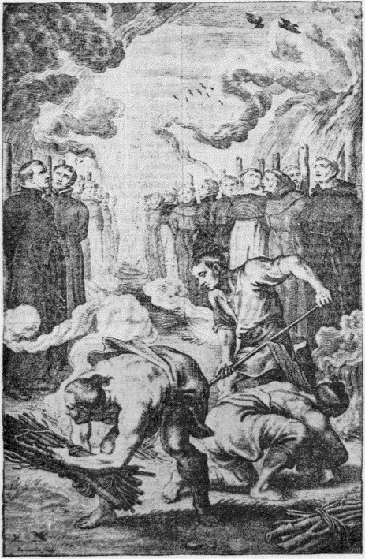Persecutions of Christians in Nagasaki, Japan
On August 9, 1945 an atomic bomb called "Fat Man" was dropped on Nagasaki, Japan. This bomb killed more than 80,000
people and caused immense havoc and pain.
But there is something else about Nagasaki, the dreadful persecutions of christians in the late 1500's and early 1600's.
Christians were hanged, drowned, beheaded, roasted and burned to death. The Japanese exterminators of christianity found
killing believers was the only effective method of attaining their ends.


Image 1. Drowning Christian converts at Nagasaki, 1627.
The hands of the victims were bound behind their backs and stones tied about their necks before they were pushed into the water.
Image 2. Death by the "fosse" The victims were lowered head first into holes in the ground and suspended in this
position until they died three or four days later. One hand was left free to make signs of recantation.

Image 3. Burning of priests and converts at Nagasaki in 1597. Burning at the stake was one of the favorite methods of exterminating
Christians in Japan at that time.
Japan, of all the nations which have been closed to foreign influences, is considered to be most open to it to-day. Christians may travel
where they please within the territory of Dai Nippon . They may also establish Christian colleges and churches without let or hindrance. The rulers of the Land of
the Chrysanthemum are glad to make use of the knowledge and inventions fo the Christian world.
One would never imagine from present conditions that the long seclusion of the Japanese was due to the spread of Christianity in their country three hunderd years ago.
The Japanese have earned a reputation for their enlightened treatment of Russian prisoners. No one would imagine that there was ever a time when they practised
cruelties almost unbelievable upon Christians. In fact, the Japanese came as near to stamping out a firmly rooted mission of the Christian faith as any nation has been able to do.
Originally Japan allowed foreigners to settle in her borders,and in the early part of the seventeeth century Christian missionaries had made as many as 300,000 native converts.
Between 1614 and 1635, it is said 280,000 of these were punished for their faith in one horrible way or another. The persucutions of
Nero and his time are said not to have exceeded those of Japan in their inhumanity.
Christianity was introduced into Japan by Francis Xavier in 1548. It was fostered by the great Japanese leader Nobunaga, because he desired to use it as a weapon in his
attempt to subdue the Buddhists. His successors, however, believed that foreign powers were making use of the Christian religion
to bring Japan into subjection. They accordingly resolved to exclude foreigners and stamp out the Christian religion.
Men and woman were bound in sacks made of inflammable straw. Then they were piled in heaps like so much cordwood,
and set on fire. This method of persecution had a variation known as the "mino" dance.
Those who were destined to perform this "dance" were dressed in rough straw coats, made of a kind of grass with long and broad leaves, called "mino" such
as are used by the Japanese boatmen and the peasantry for rain coats.
In this dance the straw mantles were tied around the neck and body. The hands were bound tightly behind the back with ropes, and the straw coats were set on fire. Then the dancing began.
As might be expected some died from the effects of their burns Others in their anguish, threw themselves into water, and, their hand being tied, were drowned.
Women were tormented in almost unthinkable ways. They were sometimes strung up naked by the legs. Women and girls were stripped of their clothing and
compelled to crawl on all fours through the streets. After this they were thrown into tubs full of writhing snakes. In the "Great Martyrdom" of Nakasaki thirty
Christians were beheaded.
Twenty-five others, among them, foreign priests were roasted to death. A great pit was prepared. A bed of charcoal was spread upon its bottom.
Mixed with it were the ashes of those who had been burned to death.
On this mixture were the bodies laid of the decapitated. These were buried beneath a layer of wood. On top of this were piled a great number of Christian images, rosaries, and
other objects used in connection with the exercise of the Christian religion.
Fire was applied. For two days the mass smouldered. Bags then were prepared, and into them were collected the ashes and even the earth which bore the stain of the Christian blood.
Boatmen were dispatched with the bags to distribute the contents upon the open sea. Afterwards the boatmen were made to strip and bath, wash the bags and even the boats so that no
dust or other evidence of the existance of the martyrs should remain. Nothing that was Christian would be tolerated.
Bodies of Christian were exhumed and consigned to the flames.
A torture of most devilish ingenuity was devised in 1633. This was the torment of the "fosse" A hole six feet deep and three
feet in diameter was dug. A gibbet was placed over it. The victim was then tightly corded so as to impede the flow of the blood. Sometimes he or she was tied up in a sack, the
entire person being confined except the one hand. This was left free so that the victum could make some sign of recantation if he desired.
A line previously run over the arm of wood above the hole was then fastened around his ankles.
Little incisions were made in the temples to prevent too rapid a congestion of the blood and to prolong the pain. Then the victim
was lowered into the hole head foremost. Soon blood began to ooze from the mouth, the nose and ears. It is said that for the
most death came only at the end of two, three and four days. In some cases the end was deferred even six days.
The Japanese exterminators of Christianity found that killing believers was the only effective method of attaining their end.
Few recanted. Women went to the stake carrying there babies that these might die with them rather then live to be brought up
as pagans. Foreigners were then forbidden to land on the Japanese coast under penalty of death, and natives were forbidden
to leave the island. All relics of the Christian religion were distroyed as fas as they could be found. The time came at last when
the Japanese leaders felt that they had accomplished what perhaps had not been accomplished in any other nation, and had extirpated Christianity.